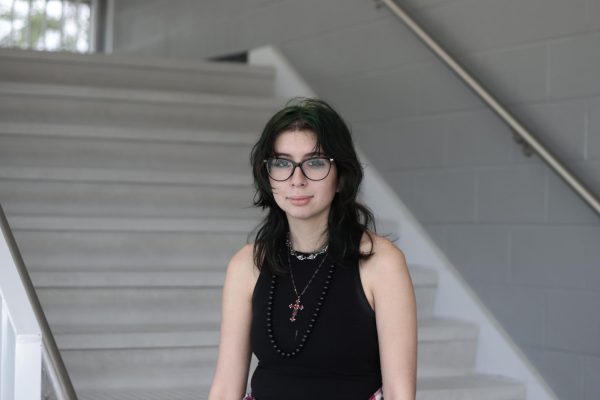Nine years after its initial release, “1989” is still considered one of Taylor Swift’s most iconic albums. Not only did it shift the trajectory of her music from country to pop, but it also propelled her further into superstardom.
However, with this success also came hardship. In her 2020 documentary “Miss Americana,” Swift opened up about the intense media frenzy surrounding her love life during these years, and the pressure she faced to musically and personally outperform previous accomplishments of her career.
Swift reclaims both the good and the bad of this era in her re-recording of “1989 (Taylor’s Version).”
Dedicated fans, also known as Swifties, were quick to point out the symbolism of the new album cover. In the original photo shoot, Swift had planned on smiling in the frame, but after feeling self-conscious, changed it to a straight face. Now, throughout the Taylor’s Version album cover and Polaroids, Swift is more joyful and self-assured. The same can be said about the vocals in the album.
Classics like “Shake it Off” and “Blank Space” have a sassier feel this time around, as Swift channels her experiences of being perceived through the public eye. “Wonderland” and “You Are In Love” stay true to the original, while being crisper and more pronounced.“I Know Places” sounds particularly impressive, as Swift combines difficult high notes with her usual stunning alto.
In an Instagram post announcing “1989 (Taylor’s Version),” Swift describes the six new vault tracks as some of her favorites. Vault tracks are unreleased songs from that era, which are included in each re-recording. This addition creates more depth within the album and highlights the versatility of Swift’s songwriting.
“Slut!” the first of the Vault Tracks depicts the dreamy beginning of a relationship, which may be worth the inevitable media obsession, which will soon follow. The soft pop melody, similar to “Clean”’ and a majority of the other vault tracks, adds to the mood of romantic anticipation. Although Swift chooses to follow her heart, the commentary surrounding it does not escape her, as she remarks “I’ll pay the price you won’t.”
“Say Don’t Go,” sounds like a sister song to the fan favorite “I Wish You Would.” Both tell the tale of wanting to save a relationship as it falls apart, though in “Say Don’t Go,” Swift is the heartbroken one. The sadness of the song is emphasized as Swift realizes that despite her yearning, her partner will never ask her to stay.
“Now That We Don’t Talk” is Swift’s shortest song ever, being a little over two minutes long. However, it still packs a punch, as the singer reflects on how she changed after a break-up. While there is initial sadness over no longer being in her ex’s confidence, there is also freedom in being herself again. Swift no longer has to pretend that she “likes to be on a mega-yacht/with important men who think important thoughts.” These lines may seem a little comical, but they also exert confidence. Swift is returning from a world of fame-obsessed celebrities and is better off without it.
“Suburban Legends” explores an iconic relationship that turned sour, as Swift “[broke her] own heart” and her “life is ruined.” Although both people in the relationship were born to be remembered, this fact cannot keep them together, and eventually they become “national treasures” individually.
“Is It Over Now” concludes the regular edition of “1989 (Taylor’s Version),” and is a three-minute-long emotional rollercoaster. Ranging from hurt to questioning to resignation, Swift wonders about the finality of a breakup. Swift sees her old partner moving on, admitting that she too has tried to do so, yet still deep down hopes for reconciliation. This is not enough to erase the singer’s suffering, as she calls her ex a “lying traitor,” and “[surmises] that if she has blue eyes [they] will probably date her.”
A common criticism of the vault tracks has been the production, as they hold similarities to her tenth album “Midnights.” However, the more gentle pop melodies allow for Swift’s songwriting to shine through and resonate with listeners, which could have been overpowered by heavy bass and drums otherwise. In addition, producer Jack Antanoff is a central collaborator on both projects, so it makes sense for them to be similar in sound. Antonoff is known to excel in producing alt-pop music, which Swift has leaned into throughout the past couple of years.
“1989 (Taylor’s Version)” is the fourth re-recording in Swift’s career, as she works to regain her masters back. The success of these re-recordings surprised critics and fans alike, as they topped the Billboard charts and earned Swift the #1 spot for “All Too Well (Ten Minute Version).” “1989 (Taylor’s Version)” broke the Spotify record for the most listened-to album in a day, replacing her tenth album “Midnights.” This proves yet another reason for Swift to return to this era more self-assured; her fans are just as dedicated to the project as she is.
“1989” marked many things for Swift’s career, but most of all, her first venture into the pop world. While it was a successful one, it was also a time of learning and improving her craft, which would eventually allow her to write three acclaimed pop albums and two alternative ones. In this re-recording, Swift has taken all of the memories, heartbreak, growth, and healing, and turned them into something special. It is a record that will withstand the test of time, as will her legacy as an incredible artist.






